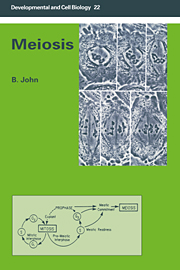Book contents
- Frontmatter
- Contents
- Acknowledgements
- Prologue
- 1 Introduction – multiplication and division
- 2 Modes of meiosis
- 3 Occurrence and timing of meiosis
- 4 Events and mechanisms of meiosis
- 5 Chromosome disjunction
- 6 The genetic control of meiosis
- 7 Sequences and consequences of meiosis
- 8 Evolutionary aspects of meiosis
- Postlogue
- References
- Index
6 - The genetic control of meiosis
Published online by Cambridge University Press: 21 January 2010
- Frontmatter
- Contents
- Acknowledgements
- Prologue
- 1 Introduction – multiplication and division
- 2 Modes of meiosis
- 3 Occurrence and timing of meiosis
- 4 Events and mechanisms of meiosis
- 5 Chromosome disjunction
- 6 The genetic control of meiosis
- 7 Sequences and consequences of meiosis
- 8 Evolutionary aspects of meiosis
- Postlogue
- References
- Index
Summary
The typical mutant deficient in general recombination is either sick or dead.
Alan CampbellAll the events of meiosis are under some form of genetic control and mutations which are defective in functions specific to meiosis have been identified in a variety of eukaryotes (Rees, 1961; Baker et al., 1976; Sears, 1976; Golubovskaya, 1979). Table 6.1, for example, summarizes the principal categories of mutations identified in plants. From such cases it has been inferred that the normal alleles of such mutations produce gene products that play crucial roles in regulating the meiotic activities of chromosomes in space and time. Like mutations generally, those which influence chromosome behaviour most commonly have deleterious consequences and lead to an impairment of the efficiency of meiosis. They have been most thoroughly characterized in the fruit fly Drosophila melanogaster and in the yeast Saccharomyces cerevisiae.
MEIOTIC MUTATIONS IN DROSOPHILA
A majority of mutations in Drosophila affect only one sex. This is not surprising when one recalls that SC formation and crossing-over is restricted to the female.
Male mutations
Microtubules, as we have seen, are dimers composed of equimolecular amounts of two 50000 dalton subunits, α-and β-tubulin. While there are other microtubule-associated proteins, the tubulins are the only ones that have been shown to play a role in chromosome movement since they are the principal functional components of the spindle microtubules. A specific β2-tubulin subunit has been identified which is expressed only at male meiosis in D. melanogaster and so functions in the production of the meiotic, but not the mitotic, spindle as well as in the differentiation of the axoneme of the male sperm (Kemphues et al., 1982).
- Type
- Chapter
- Information
- Meiosis , pp. 248 - 270Publisher: Cambridge University PressPrint publication year: 1990



